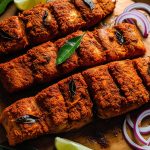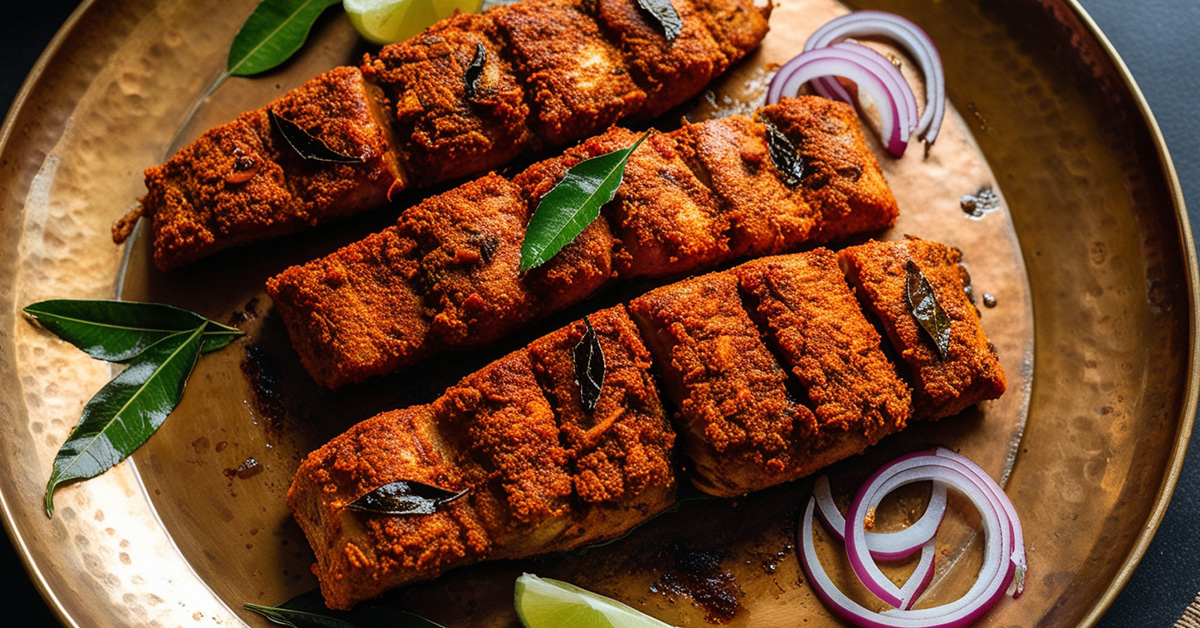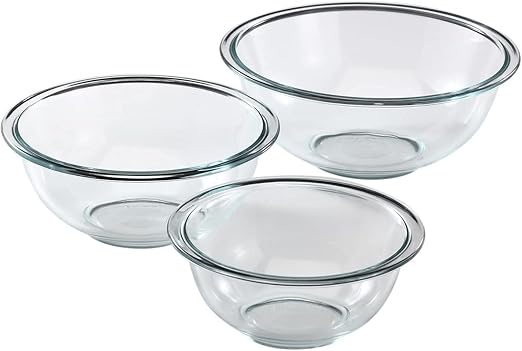Disclosure: As an Amazon Associate and participant in other affiliate programs, we earn from qualifying purchases. We only recommend products we believe will provide value to our readers.
Want to become skilled at making the authentic Indian fish fry recipe that Indian families have cherished for generations? This classic dish brings together crispy, well-seasoned fish with aromatic Indian spices. The result is a delicious meal you can prepare at home. Your search for the perfect fish fry recipe ends here. We will show you how to create this beloved dish step by step.
This detailed guide shows you everything about Indian fish fry. You will learn to pick the best Kingfish and create the perfect fish masala recipe. The guide reveals key marination techniques, cooking methods, and expert tips. These help you achieve a crispy exterior while the fish stays tender and juicy inside. The recipe delivers impressive results every time, whether you cook for a family dinner or plan a special occasion.
Table of Contents
What Makes Indian Fish Fry Special
Indian fish fry stands out from other fish dishes because of its amazing regional diversity and intricate spice combinations. Each region of India adds its own special touch to this cherished dish:
- Andhra Style: Known for high heat levels and generous use of garam masala
- Tamil Style: Distinguished by liberal use of aromatic fennel seeds
- Kerala Style: Characterized by fish pan-fried in traditional coconut oil
- East Indian Style: Features the unique bottle masala, a complex spice blend
The sort of thing I love about Indian fish fry is its adaptability. You can cook it several ways – pan-frying, grilling, or even barbecuing. Your fish fry becomes exceptional through its marinade. This combines hand-pounded spices that families have perfected through generations.
This dish shines because you can adjust the spice levels exactly how you like them. Some regions use specific spice blends like East India’s bottle masala, which takes a year to prepare. You can create equally tasty versions with basic pantry ingredients. The marinade works its magic as the fish soaks up your chosen spices’ flavors.
This adaptable dish fits perfectly into your routine. It works great for quick weekday meals and special occasions while keeping its authentic Indian essence.
All About Kingfish – The Perfect Choice for Fish Fry
Kingfish makes the perfect choice for an Indian fish fry. Its sweet, tender, and amazingly flaky texture appeals to everyone, including people who don’t usually enjoy seafood. The thick white filets contain minimal bones and work well with many cooking methods.
Smaller Kingfish between 24-30 inches give you whiter, more delicate meat. These cuts deliver excellent results in your Indian fish fry recipe. You can pan-fry or grill them with consistent success.
Here are the key tips to make the most of your Kingfish:
- Soak filets in ice water until cooking time to preserve taste and texture
- Cook on medium heat for optimal results
- Avoid deep-fat frying as the fish is naturally fatty
- Store properly as Kingfish’s taste fades faster than other fish
- Clean and prepare immediately after purchase
Kingfish adapts beautifully to Indian cooking methods while keeping its unique characteristics. Pan-frying works exceptionally well, creating a crispy exterior with a succulent inside. The fish’s mild flavor perfectly complements your favorite Indian masalas and spice blends.
Read also: How to Make Zatarains Fish Fry Recipe
Essential Indian Masalas for Perfect Fish Fry
A perfect Indian fish fry gets its magic from an aromatic masala blend. Your ideal fish masala recipe needs these key spices:
- Red chili powder to add heat
- Turmeric powder to give color and health benefits
- Garam masala to create depth
- Coriander powder to bring earthiness
- Black pepper to pack a punch
- Curry leaves to deliver authentic flavor
The masala preparation needs freshly ground ginger and garlic paste as a vital ingredient that adds flavor and removes any fishy smell. Mixing your masalas with coconut oil instead of water creates a game-changing combination that boosts the overall flavor profile.
The recipe allows you to explore three classic masala variations. The traditional red masala blends chili powder, coriander seeds, and fenugreek seeds with tamarind extract. A simpler version combines chili powder with turmeric and garlic. The green masala variation offers a refreshing twist that uses fresh green chilies, coriander leaves, and mint.
Indian spices deliver more than just flavor. These spices contain natural anti-bacterial properties that preserve the fish and add zero calories. Your marinade’s best results come from preparing it separately before applying it to the fish. This method lets you perfect the seasoning according to your taste.
You may like: Fried Swai Fish Recipe

Fish Fry Recipe Indian
- Total Time: 55 minutes
Description
Make your Kingfish a mouth-watering feast using this double marination technique. The method ensures your fish turns out perfectly seasoned and crispy. The recipe blends traditional Indian spices with modern cooking methods to create an authentic dish you can easily prepare at home.
A double marination technique makes this classic Indian fish fry special and helps your Kingfish absorb rich flavors while creating a crispy exterior. The recipe takes about an hour to prepare. Both novice and expert cooks can achieve restaurant-quality results with this method.
Ingredients
Main Ingredient:
- 500g Kingfish, cut into medium-sized steaks (about 1-inch thickness)
First Marination:
- 1 tbsp ginger garlic paste
- Lemon juice (add as needed)
- ¼ tsp turmeric powder
- ¾ tsp garam masala
- ½ tsp red chili powder
- Salt to taste
Second Marination:
- 1½ tbsp rice flour
- 1½ tbsp gram flour
- ¼ tsp red chili powder
- Fresh curry leaves, finely chopped
- Salt to taste
For Frying:
- Oil for deep frying (mustard or vegetable oil)
Instructions
- Create a paste by combining the first marination ingredients.
- Take clean fish pieces and coat them with the paste, then let them rest for 15 minutes.
- Mix all second marination ingredients together.
- Take the marinated fish and coat it thoroughly with the dry mixture.
- The flour will become moist after 10-15 minutes of resting time.
- Make sure the oil is hot in your pan.
- Place the fish in medium heat and cook until it turns golden brown.
- Carefully flip each piece and cook until the other side matches.
Notes
- Coconut oil adds authentic Kerala flavor
- Let the marinade work its magic between layers
- Heat the oil properly before starting to fry
- Handle the flips with care to protect the coating
- Prep Time: 40 minutes
- Cook Time: 15 minutes
- Category: Seafood
- Method: Frying
- Cuisine: Indian
Health Benefits of Indian Fish Fry
You might be surprised by the health benefits hiding in your favorite Indian fish fry! This classic dish offers more than its amazing taste and makes a smart addition to your weekly menu.
Your Indian fish fry comes packed with these health benefits:
- Heart-Healthy Omega-3s: Rich in monounsaturated and polyunsaturated fats that help prevent heart disease
- Blood Sugar Control: Contains MUFAs that help regulate blood sugar levels
- Brain Booster: High in DHA that supports cognitive function and helps reduce depression risks
- Joint Care: Natural anti-inflammatory properties help ease arthritis symptoms
- Blood Pressure Management: High potassium content helps maintain healthy blood pressure
The preparation method makes your Indian fish fry even more beneficial. Pan-frying fish in healthy oils like olive oil preserves most nutritional benefits while delivering authentic taste. Your meal becomes even healthier when you combine fish with traditional Indian masala spices that add anti-inflammatory and antioxidant properties.
You should include fish in your diet at least twice a week to get the maximum health benefits. Note that moderation works best – about 1750mg of fish per week helps you maintain these health benefits and keeps your diet balanced. The best part? You get to enjoy one of India’s most beloved culinary traditions while eating healthy!
Nutritional Information
The nutritional profile of Indian fish fry can help you make better dietary choices. A typical serving (350g) of this flavorful dish contains 406 calories, which makes it a reasonable main course option.
Here’s what you get in each serving:
| Nutrient | Amount | % Daily Value |
| Protein | 30g | 60% |
| Total Fat | 9.5g | 12% |
| Carbohydrates | 49g | 18% |
| Sodium | 1,000mg | 43% |
Your Indian fish fry delivers these essential nutrients:
- High-quality protein (60% of daily value)
- Heart-healthy omega-3 fatty acids
- Vitamin D (62% of daily value)
- Selenium (67% of daily value)
- Vitamin B12 (186% of daily value)
The traditional fish masala recipe creates a dish that’s low in saturated fats (4.2g) and rich in beneficial mono and polyunsaturated fats. Its protein content makes it an excellent choice to support muscle maintenance and growth. The moderate calorie count helps maintain a balanced diet effectively.
Your body benefits from the dish’s rich mineral content. It provides potassium (479mg), phosphorus (139mg), and iron (1.8mg). These minerals are the foundations of your body’s electrical balance, bone health, and oxygen transport.
Another Indian Fish Recipe you may like: Traditional Kerala Fish Recipe
Tips for Making the Perfect Indian Fish Fry
Become skilled at creating crispy Indian fish fry with these game-changing tips that professional chefs swear by.
Perfect Preparation Pat your fish dry with paper towels – this significant step will give a coating that sticks and creates that signature crispy exterior. Your fish should rest uncovered in the refrigerator for 30 minutes before cooking to achieve better results.
Everything in Cooking
- Keep oil temperature between 350-365°F for optimal crispiness
- The pan should remain uncovered while frying to prevent steam
- Each piece needs to fry until it releases naturally from the pan
- Leave space between pieces to maintain temperature
- A wire cooling rack works better than paper towels for draining
Temperature Control Matters Oil temperature is your secret weapon to perfect Indian fish fry. Cold oil leads to oily, soggy fish. Hot oil burns the outside before cooking the inside properly. A thermometer helps with precision, and waiting between batches maintains consistent heat.
Finishing Touches Your fish needs just one gentle turn while flipping. The crispy coating stays intact and juices settle nicely when the fish rests on a cooling rack for a few minutes before serving.
Note that patience is your best friend to create the perfect Indian fish fry. Each step deserves time and attention that will reward you with restaurant-quality results consistently.
Serving Suggestions and Accompaniments
Lift your dining experience by pairing Indian fish fry with perfect accompaniments. The crispy fish plays the starring role, and carefully selected sides can make your meal extraordinary.
Your authentic Indian experience starts with fluffy steamed rice and thinly sliced red onions. A cooling yogurt-based raita balances the spiced fish and adds creamy texture to your plate.
These crowd-pleasing sides complement your fish fry:
- Crispy onion bhajis with mint chutney
- Buttery naan or roti for mopping up flavors
- Gujarati-style spiced cabbage
- Lemon-dressed cucumber salad
- Dhal for extra protein and comfort
You might want to try some contemporary twists with your Indian fish fry. Light coleslaw brings wonderful crunch, while roasted zucchini or sautéed corn add healthy, colorful options. Tartar sauce takes on an Indian flair with a pinch of chat masala!
Something cooling on your plate helps balance the heat and enhances the meal’s flavors. A simple cucumber raita or mint-flavored yogurt works perfectly. A fresh green salad with lemon juice and black pepper creates a complete meal.
Best Occasions to Serve Indian Fish Fry
Want to add a special touch to your next gathering? Indian fish fry stands out as the perfect centerpiece for countless celebrations throughout the year. This versatile dish fits every occasion, from intimate family dinners to grand community feasts.
Summer gatherings work best to serve your Indian fish fry. Its aromatic spices and crispy texture make it an instant crowd-pleaser at backyard parties and weekend get-togethers. Your guests will love the blend of traditional masalas and perfectly fried fish as they enjoy the seasonal warmth.
Your special occasions become more memorable with this classic dish. Here’s where your Indian fish fry shines:
- Traditional festival celebrations
- Family reunions and gatherings
- Community fundraising events
- Church get-togethers
- Cultural demonstrations
- Birthday celebrations
- Holiday feasts
Planning for larger gatherings? An average portion (about 700 grams) serves 4-5 people comfortably. Your Indian fish fry recipe works great for feeding a crowd while keeping authentic flavors intact. This dish’s true beauty lies in knowing how to bring people together and create lasting memories around a shared love for traditional Indian cuisine.
Variations of Indian Fish Fry Recipes
Indian regional fish fry variations offer their own unique twist to this beloved dish. The flavors range from coastal specialties to inland favorites, and you’ll find a world of tastes waiting for you.
Kerala Style features a distinctively spicy preparation where fish marinates in ginger-garlic paste, red chili powder, and black pepper powder. Pure coconut oil and curry leaves create its irresistible aroma that defines Kerala’s cuisine.
The Bengali Style fish fry stands out with its different approach. This version features a crispy coating made with egg, flour, and breadcrumbs. Coriander powder and garam masala add the signature Bengali touch.
Here are some must-try regional variations:
- Karimeen Fry – Kerala’s pearl spot fish delicacy
- Apollo Fish Fry – Hyderabad’s spicy restaurant-style preparation
- Bombil Tawa Fry – Mumbai’s famous Bombay Duck preparation
- Meen Pollichathu – Fish wrapped in banana leaves and pan-fried
Different fish varieties can create unique flavors. Pomfret offers a delicate taste, while mackerel provides a stronger flavor profile. Each fish’s character allows you to create countless variations of this classic recipe.
Storage and Leftover Guidelines
The quality of your Indian fish fry depends on proper storage. Fresh off the pan tastes best, but you might need to store leftovers sometimes. Let me show you how to keep your fish fry safe and delicious.
A cooling rack works better than a plate to store freshly cooked fish fry. This method lets moisture escape evenly and keeps the crispy coating from getting soggy. The fish fry needs airtight packaging or sealed containers after cooling to lock in moisture and block other food odors.
These storage guidelines will help:
- Store in the refrigerator within two hours of cooking
- Keep temperature below 40°F (4°C)
- Use within 3-4 days to best quality
- Wrap tightly in plastic wrap or aluminum foil
- Place in airtight containers to prevent odor transfer
Watch for Signs of Spoilage: Your senses will tell you if stored fish fry has gone bad. Discard leftovers if you notice odd smells, texture changes, or unusual appearance. Note that refrigeration only slows bacterial growth, so stay on the safe side.
The crispy texture suffers during reheating, but you can bring life back to leftover pieces. Heat them in a preheated oven at 350°F for a few minutes. The best approach is to cook only what you plan to eat right away.
Conclusion
Creating delicious Indian fish fry combines centuries-old culinary traditions with modern cooking techniques. This beloved dish highlights Indian cuisine’s adaptability through regional spice blends and preparation methods. The process of selecting fresh Kingfish and achieving a crispy exterior shows how traditional recipes work perfectly in home kitchens without losing their authentic flavor.
Indian fish fry reflects the deep cultural heritage of Indian cooking. Each region adds its own special touch to this timeless dish. The health benefits, amazing flavors, and simple preparation make this recipe a great addition to any cook’s collection. These detailed instructions and expert tips will help you create this classic dish that people have enjoyed for generations in India and beyond.













